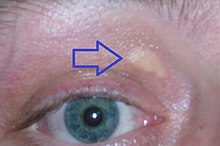User:Mr. Ibrahem/Familial hypercholesterolemia
| Familial hypercholesterolemia | |
|---|---|
| Other names | Familial hypercholesterolaemia |
 | |
| Yellowish patches of cholesterol above the eyelids. These are more common in people with FH. | |
| Specialty | Endocrinology |
| Symptoms | Yellowish lipid deposits within the skin, tendons, or eyes[1] |
| Complications | Cardiovascular disease[1] |
| Causes | Genetic disorder[1] |
| Risk factors | Family history[1] |
| Differential diagnosis | Cerebrotendinous xanthomatosis, sitosterolemia, hypercholesterolemia[1] |
| Treatment | Lifestyle changes, medication, apheresis[1] |
| Medication | Statins, ezetimibe, PCSK9 inhibitors[1] |
| Frequency | 1 in 250 people (USA)[1] |
Familial hypercholesterolemia (FH) is a group of genetic disorders characterized by very high cholesterol levels.[1] Symptoms may include yellowish lipid deposits within the skin, tendons, or eyes.[1] Complications may include heart disease and stroke at an early age.[1] Among those less than 45 who have a heart attack, 20% have FH.[2]
It typically occurs as a result of a mutation in the gene for the LDL receptor, apolipoprotein B (ApoB), or PCSK9.[1] One (heterozygous) or both (homozygous) genes may be involved.[1] Mutations in other genes may also rarely cause the disease.[1] Screening the general population for the condition is recommended.[2] FH may be classified as a type IIa, IIb, or III dyslipidemia.[1]
Treatment involves a healthy diet, stopping smoking, and exercise.[1] The first line medication is high dose statins to which ezetimibe or PCSK9 inhibitors may be added.[1] Other measures may include mipomersen, lomitapide, LDL apheresis (removal of LDL in a method similar to dialysis) and liver transplantation.[3][1]
FH affects about 1 in 250 people in the United States.[1] About 1 in 400 people have one copy of a gene affecting the LDL receptor; while two copies occurs in 1 about in a million.[2][1] Males and females are affected equally frequently.[1] Some populations such as French Canadians and Dutch Afrikaners are more commonly affected.[2] The condition was first described in 1938.[4]
References[edit]
- ^ a b c d e f g h i j k l m n o p q r s t u Vaezi, Z; Amini, A (January 2020). "Familial Hypercholesterolemia". PMID 32310469.
{{cite journal}}: Cite journal requires|journal=(help) - ^ a b c d Hopkins, PN; Toth, PP; Ballantyne, CM; Rader, DJ; National Lipid Association Expert Panel on Familial, Hypercholesterolemia. (June 2011). "Familial hypercholesterolemias: prevalence, genetics, diagnosis and screening recommendations from the National Lipid Association Expert Panel on Familial Hypercholesterolemia". Journal of clinical lipidology. 5 (3 Suppl): S9-17. doi:10.1016/j.jacl.2011.03.452. PMID 21600530.
- ^ Rader DJ, Cohen J, Hobbs HH (2003). "Monogenic hypercholesterolemia: new insights in pathogenesis and treatment". J. Clin. Invest. 111 (12): 1795–803. doi:10.1172/JCI18925. PMC 161432. PMID 12813012.
- ^ Januzzi, James L. (2011). Cardiac Biomarkers in Clinical Practice. Jones & Bartlett Learning. p. 786. ISBN 978-0-7637-6161-5. Archived from the original on 2021-08-28. Retrieved 2020-11-20.
